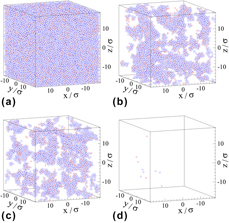Crossref Citations
This article has been cited by the following publications. This list is generated based on data provided by
Crossref.
Liu, Qing-Long
and
Priezjev, Nikolai V.
2019.
The influence of complex thermal treatment on mechanical properties of amorphous materials.
Computational Materials Science,
Vol. 161,
Issue. ,
p.
93.
Priezjev, Nikolai V.
2019.
Accelerated relaxation in disordered solids under cyclic loading with alternating shear orientation.
Journal of Non-Crystalline Solids,
Vol. 525,
Issue. ,
p.
119683.
Jana, Pritam Kumar
and
Priezjev, Nikolai V.
2020.
Structural relaxation in amorphous materials under cyclic tension-compression loading.
Journal of Non-Crystalline Solids,
Vol. 540,
Issue. ,
p.
120098.
Priezjev, Nikolai V.
2020.
Cooling under Applied Stress Rejuvenates Amorphous Alloys and Enhances Their Ductility.
Metals,
Vol. 11,
Issue. 1,
p.
67.
Priezjev, Nikolai V.
2020.
Alternating Shear Orientation During Cyclic Loading Facilitates Yielding in Amorphous Materials.
Journal of Materials Engineering and Performance,
Vol. 29,
Issue. 11,
p.
7328.
Priezjev, Nikolai V.
2020.
A delayed yielding transition in mechanically annealed binary glasses at finite temperature.
Journal of Non-Crystalline Solids,
Vol. 548,
Issue. ,
p.
120324.
Shang, Baoshuang
Wang, Weihua
Greer, Alan Lindsay
and
Guan, Pengfei
2021.
Atomistic modelling of thermal-cycling rejuvenation in metallic glasses.
Acta Materialia,
Vol. 213,
Issue. ,
p.
116952.
Priezjev, Nikolai V.
2021.
Shear band healing in amorphous materials by small-amplitude oscillatory shear deformation.
Journal of Non-Crystalline Solids,
Vol. 566,
Issue. ,
p.
120874.
Priezjev, Nikolai V.
2021.
Accessing a broader range of energy states in metallic glasses by variable-amplitude oscillatory shear.
Journal of Non-Crystalline Solids,
Vol. 560,
Issue. ,
p.
120746.
Priezjev, Nikolai V.
2021.
Yielding transition in stable glasses periodically deformed at finite temperature.
Computational Materials Science,
Vol. 200,
Issue. ,
p.
110831.
Priezjev, Nikolai V.
2021.
Accelerated rejuvenation in metallic glasses subjected to elastostatic compression along alternating directions.
Journal of Non-Crystalline Solids,
Vol. 556,
Issue. ,
p.
120562.
Chen, Tzu-Chia
Nasution, Mahyuddin KM
Jabbar, Abdullah Hasan
Shoja, Sarah Jawad
Siswanto, Waluyo Adi
Pranoto, Sigiet Haryo
Bokov, Dmitry
Magizov, Rustem
Mustafa, Yasser Fakri
Surendar, A.
Zalilov, Rustem
Sviderskiy, Alexandr
Vorobeva, Alla
Vorobyev, Dmitry
and
Alkhayyat, Ahmed
2022.
Effect of spatial heterogeneity on level of rejuvenation in Ni80P20 metallic glass.
Chinese Physics B,
Vol. 31,
Issue. 9,
p.
096401.
Priezjev, Nikolai V.
2022.
Mechanical annealing and yielding transition in cyclically sheared binary glasses.
Journal of Non-Crystalline Solids,
Vol. 590,
Issue. ,
p.
121697.
Huo, Juntao
Li, Kangyuan
Zang, Bowen
Gao, Meng
Wang, Li-Min
Sun, Baoan
Li, Maozhi
Song, Lijian
Wang, Jun-Qiang
and
Wang, Wei-Hua
2022.
High Mixing Entropy Enhanced Energy States in Metallic Glasses.
Chinese Physics Letters,
Vol. 39,
Issue. 4,
p.
046401.
Jana, Pritam Kumar
and
Priezjev, Nikolai V.
2023.
Relaxation dynamics in amorphous alloys under asymmetric cyclic shear deformation.
Journal of Non-Crystalline Solids,
Vol. 600,
Issue. ,
p.
121996.



